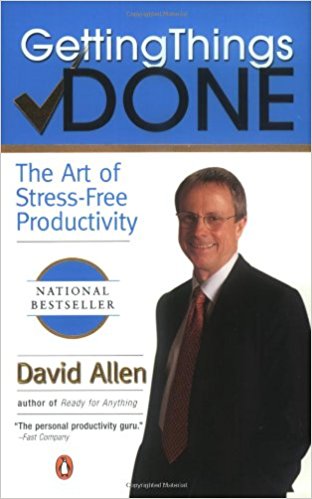Have you reached a point in your career where even thinking about your calendar makes your stomach turn? The things you need to do are piling up and you don’t even know where to start?
You keep thinking that this is going to be a busy phase, but the stress wears you down as time goes on and you never become less busy. Luckily for you, we have the solution!

getting things done
by David Allen
⏱ 11 minutes reading time
🎧 Audio version available
One in, One Out
There is an awesome rule that’s a game changer in changing how entrepreneurs deal with their schedules.
The “one in, one out” method is as easy as it sounds. In order to control the number of tasks you have, especially if you’re working with a specific time frame, is that for every new thing you plan to add to your calendar, finish another task first.
Not only does it reduce stress and keep your to-do list from getting too long, but it also declutters your schedule.
Limit Your Yeses
Your schedule is overwhelming because it’s packed to the brim with tasks you can’t possibly fit in. That sense of overwhelm is magnified by the little time you have, the little rest you have, and not knowing which tasks need priority.
Take a look at your schedule and think about which tasks you could have avoided if you didn’t say “yes” so often. Be honest with your co-workers if they’re pushing some of their workloads on you. All those yeses result in either two things:
One is that your schedule becomes impossible to manage. The busier it is, the less time you have, and the more likely you are to not accomplish a lot of these tasks.
The second thing is you work yourself to exhaustion and end up getting burnt out.
Sort Your Tasks Into Quadrants
Okay, so you have your schedule and to-do list narrowed down to only the most necessary bits. Now what? How do you determine which ones hold the most importance?
A tried and tested method of sorting out your schedule is detailed in the business book, The 7 Habits of Highly Effective People: Powerful Lessons in Personal Change by Stephen Covey.
Covey found that the most effective method is to divide activities and sort them by both importance and urgency. Then he places them into one of four quadrants.
The first quadrant is the easiest one to determine. The most pressing tasks take precedence here. Important deadlines, crises you need to deal with, and important meetings.
The second quadrant is all the things that involve planning and setting long-term goals.
Thirdly, you have things that are less important, but are no less urgent. Things like returning calls and replying to emails. Events and regular meetings should be placed here.
The last quadrant is the list of unimportant and non-urgent items. Here is the good news! This quadrant is reserved for you. It’s the non-work things, like scrolling through social media, binging TV shows, et cetera.
The purpose of sorting your tasks into quadrants doesn’t just bring you peace of mind. It also helps you become the most productive version of yourself. When people try this method, they’re often surprised about how many of their daily tasks actually fall into the third and fourth quadrants.
Save Time With Time Frames
All right, now what to do with the tasks that require the most effort? And what to do with the ones that require less effort, but will be more time consuming?
In order to stay in control of your schedule and complete things on time, setting a time frame for every task is essential and life saving. Take a look at your to-do list and determine the time needed for each task. You know answering emails won’t take the same amount of time as writing a report, for example.
This way, a task won’t take up a large chunk of your day before you realize what’s happening. If you’re working on something and it’s taking longer than expected, if it’s not that important of a task, feel free to put it aside and focus on the next task, in order to be as efficient as possible.
Eat the Frog
“Eat the frog” is a quote by Mark Twain that fits perfectly for those who are trying to stay on top of their tasks. The whole sentence is “Eat a live frog first thing in the morning and nothing worse will happen to you the rest of the day. And if it’s your job to eat two frogs, it’s best to eat the biggest one first.”
Author Brian Tracy went on to apply this quote to task management. He suggests that each day, everyone has that one dreaded or super important task. However, with an entire day stretching ahead, most people tend to put off that task until they settle in, until they check their email, until they– the list goes on. The task ends up being pushed back until it makes your stomach turn just thinking about it.
So do as Mark Twain and Brian Tracy suggest and tackle your own business “frog” first thing– the task you’re most likely to procrastinate about. Whether it’s a deadline, a presentation, research; do it first, before anything else, and just get it over with.
With the troublesome task out of the way, the rest of the day will suddenly seem far less daunting.
Apply the Inbox Zero Method
The Inbox Zero method is a brutal and efficient approach to email management that keeps your inbox empty. If you receive dozens of emails a day, you know how time-consuming and energy-draining it can be to reply– not to mention how email notifications tend to interrupt focus.
The obvious approach is to not reply to each email as soon as it comes in. But the Inbox Zero method goes beyond that. Productivity expert Merlin Mann developed it. Mann says that the “zero” doesn’t actually refer to the number of messages you have in an inbox. Instead, it refers to the “amount of time an employee’s brain” is in their inbox.
Mann has five actions you can take to deal with each email. They are: delete, delegate, respond, defer, and do.
To put his philosophy in a nutshell: periodically check your emails and organize them into folders. Messages that will take less than two minutes are ones you can respond to immediately. Any other emails– and any messages that can be answered later on– those can go into a “requires response” folder.
Each day, pencil in a period of time where you’ll address the “requires response” folder.
You’ll be surprised how organized your lifefeels when your inbox isn’t a stress-inducing, overflowing mess.
Schedule In Breaks
Working nonstop will work in terms of ticking every task off your to-do list, but it will work for approximately a couple of days before either the quality of your work starts to decline or most importantly, your health starts to suffer.
Trust the scientists and experts. A break is just as important as any other task in your schedule. So don’t skip your lunch or coffee break. If you feel like taking a breather, five minutes won’t hurt if they result in you coming back rejuvenated for the next hour instead of fighting sluggishness.
Set Deadlines for Yourself
Deadlines are something we love to hate. While they make you feel pressed, without them something called Parkinson’s Law kicks in. Basically, Parkinson’s Law says that without deadlines, the work will expand itself to fill the time available for its completion.
It’s the same reason most people push off turning in their homework and assignments until minutes before the deadline. So if a boss comes up and says they want a report on their desk by the end of the day, most people tackle the report just before the end of the day.
Avoid this problem and clear out your schedule by setting your own deadlines. Make sure they’re not unreasonable. This way, you’ll be less likely to procrastinate.
What Is Snapreads?

With the Snapreads app, you get the key insights from the best nonfiction books in minutes, not hours or days. Our experts transform these books into quick, memorable, easy-to-understand insights you can read when you have the time or listen to them on the go.


